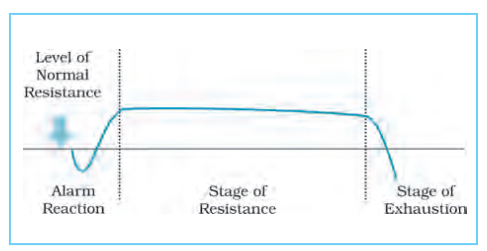- Books Name
- Psychology Book Class-12
- Publication
- PathSet Publications
- Course
- CBSE Class 12
- Subject
- Psychology
General Adaption Syndrome
- Selye studied what happens to the body when stress is prolonged, by subjecting animals to a variety of stressors (high temperature, X-rays and insulin injections) in the laboratory over a long period of time.
- He also observed patients with various injuries and illnesses in hospitals.
- He noticed a similar pattern of bodily response in all of them, which he called the General Adaptation Syndrome.
- According to him, GAS involves:
Alarm reaction stage
- The presence of a noxious stressor or stimulus leads to activation of the adrenal-pituitary-cortex system.
- This triggers the release of hormones producing the stress response.
- Now the individual is ready for fight or flight.
Resistance stage
- If stress is prolonged, the resistance stage begins.
- The parasympathetic nervous system calls for more cautions use of the body’s resources.
- The organism makes efforts to cope with the threat, as through confrontation.
Exhaustion stage
- Continued exposure to the same stressor or additional stressors drains the body of its resources and leads to the third stage of exhaustion.
- The physiological systems involved in alarm reaction and resistance become ineffective and susceptibility to stress-related diseases such as high blood pressure becomes more likely.

- Selye’s model has been criticized for assigning a very limited role to psychological factors in stress.Psychological appraisal of events is important for the determination of stress.How people respond to stress is substantially influenced by their perception, personalities and biological constitutions.

 PathSet Publications
PathSet Publications
